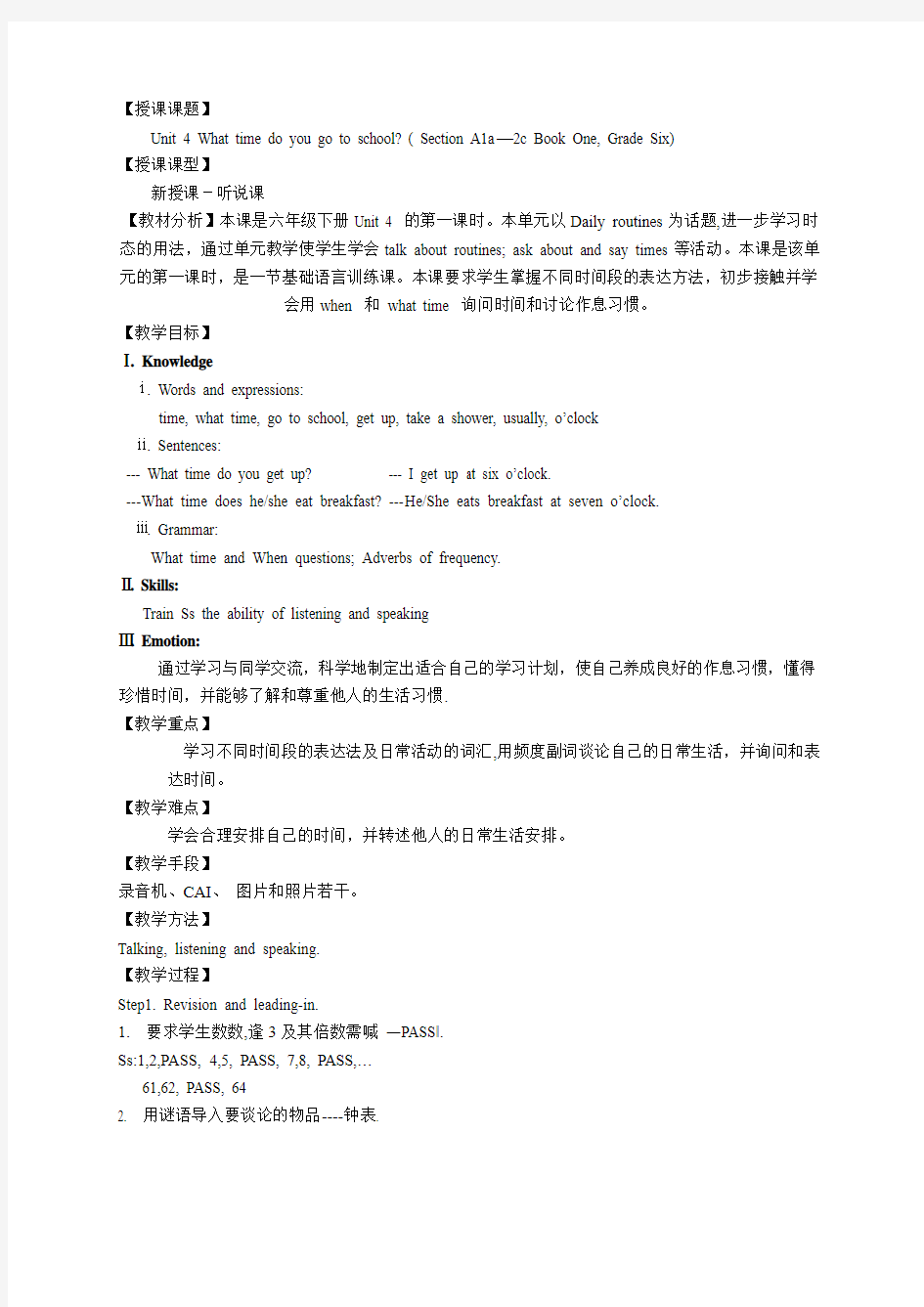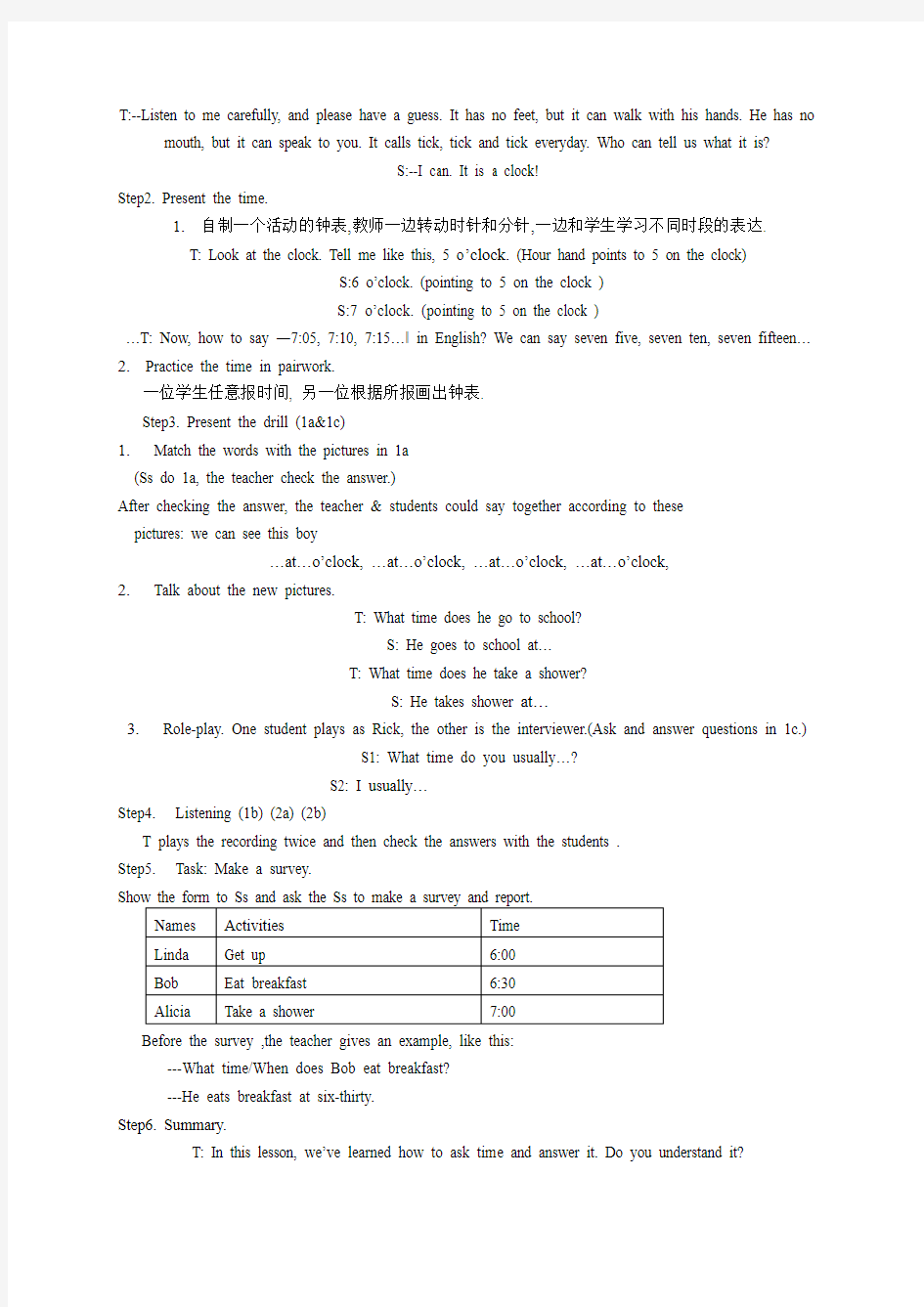Unit4What time do you go to school


【授课课题】
Unit 4 What time do you go to school? ( Section A1a—2c Book One, Grade Six)
【授课课型】
新授课-听说课
【教材分析】本课是六年级下册Unit 4 的第一课时。本单元以Daily routines为话题,进一步学习时态的用法,通过单元教学使学生学会talk about routines; ask about and say times等活动。本课是该单元的第一课时,是一节基础语言训练课。本课要求学生掌握不同时间段的表达方法,初步接触并学会用when 和what time 询问时间和讨论作息习惯。
【教学目标】
Ⅰ. Knowledge
ⅰ. Words and expressions:
time, what time, go to school, get up, take a shower, usually, o’clock
ⅱ. Sentences:
--- What time do you get up? --- I get up at six o’clock.
---What time does he/she eat breakfast? ---He/She eats breakfast at seven o’clock.
ⅲ. Grammar:
What time and When questions; Adverbs of frequency.
Ⅱ. Skills:
Train Ss the ability of listening and speaking
Ⅲ. Emotion:
通过学习与同学交流,科学地制定出适合自己的学习计划,使自己养成良好的作息习惯,懂得珍惜时间,并能够了解和尊重他人的生活习惯.
【教学重点】
学习不同时间段的表达法及日常活动的词汇,用频度副词谈论自己的日常生活,并询问和表达时间。
【教学难点】
学会合理安排自己的时间,并转述他人的日常生活安排。
【教学手段】
录音机、CAI、图片和照片若干。
【教学方法】
Talking, listening and speaking.
【教学过程】
Step1. Revision and leading-in.
1.要求学生数数,逢3及其倍数需喊―PASS‖.
Ss:1,2,PASS, 4,5, PASS, 7,8, PASS,…
61,62, PASS, 64
2. 用谜语导入要谈论的物品----钟表.
T:--Listen to me carefully, and please have a guess. It has no feet, but it can walk with his hands. He has no mouth, but it can speak to you. It calls tick, tick and tick everyday. Who can tell us what it is?
S:--I can. It is a clock!
Step2. Present the time.
1.自制一个活动的钟表,教师一边转动时针和分针,一边和学生学习不同时段的表达.
T: Look at the clock. Tell me like this, 5 o’clock. (Hour hand points to 5 on the clock)
S:6 o’clock. (pointing to 5 on the clock )
S:7 o’clock. (po inting to 5 on the clock )
…T: Now, how to say ―7:05, 7:10, 7:15…‖ in English? We can say seven five, seven ten, seven fifteen…
2.Practice the time in pairwork.
一位学生任意报时间, 另一位根据所报画出钟表.
Step3. Present the drill (1a&1c)
1.Match the words with the pictures in 1a
(Ss do 1a, the teacher check the answer.)
After checking the answer, the teacher & students could say together according to these
pictures: we can see this boy
…at…o’clock, …at…o’clock, …at…o’clock, …at…o’clock,
2.Talk about the new pictures.
T: What time does he go to school?
S: He goes to school at…
T: What time does he take a shower?
S: He takes shower at…
3.Role-play. One student plays as Rick, the other is the interviewer.(Ask and answer questions in 1c.)
S1: What time do you usually…?
S2: I usually…
Step4. Listening (1b) (2a) (2b)
Before the survey ,the teacher gives an example, like this:
---What time/When does Bob eat breakfast?
---He eats breakfast at six-thirty.
Step6. Summary.
T: In this lesson, we’ve learned how to ask tim e and answer it. Do you understand it?
Sing an English song.
Lucy and I!
I go to school at six. I go to school at six. Lucy goes to school at eight.
I go to school at six.
I go home at four. I go home at four. Lucy goes home at three, at three. I go home at four.
I go to bed at nine. I go to bed at nine. Lucy goes to bed at ten. I go to bed at nine.
Step7. Exercise.根据句意和中文提示写单词完成句子.
1.When he gets to Beijing, he usually lives in a ________ (旅馆).
2.There are many ________ (公共汽车) in our city.
3.At ________ (夜晚), he often watches TV.
4.Lily writes a ________ (信) to her mother every week.
5.He takes a ________ (淋浴) every day.
Step8. Homework
【课后反思】
本课采用了Summarizing,Accumulating,Role—playing和Comparing的学习策略,利用实物(钟表)、教学图片、幻灯片或制作多媒体课件来展开课堂, Pairwork问答式的口语交际活动和游戏活动,询问和谈论时间;通过互相询问或谈论自己或对方的作息时间安排和活动计划让学生学会合理地安排作息时间,培养学生良好的作息习惯和守时习惯。
【授课课题】
Unit 4 What time do you go to school? ( Section A3a—4 )
【授课课型】
新授课-读写课
【教材分析】本课是Unit 4 的第二课时,学生在上一节了解本单元的主要句型的基础上,机械的把人物一天的主要活动描述出来,这里给了学生一个充分的能力释放的空间,激发他们的自主学习兴趣;在本节中学生们主要是掌握如何更好的表达一天的活动;
【教学目标】
Ⅰ. Knowledge
ⅰ. Words and expressions:
work, hour, brush one’s teeth, after, go to work, get to, bus, hotel, all, night, love, listen, home, morning, go to bed, job, take the number 17 bus to a hotel, love to listen to him, watch morning TV ⅱ. Sentences:
--- What time is it? --- It’s eight-thirty.
What a funny time to eat breakfast! Can you think what his job is?
ⅲ. Grammar:
The present tense; Adverbs of frequency.
Ⅱ. Skills:
Train Ss the ability of reading and writing
Ⅲ. Emotion:
通过互相询问或谈论自己或对方的作息时间安排和活动计划,可以培养学生良好的作息习惯和守时习惯。
【教学重点】
Lead the Ss to use the words and useful expressions about daily routines
correctly.
【教学难点】
To help the students express their days and write a short passage.
【教学手段】
Multimedia; PPT; Tape-recorder
【教学方法】
Talking, reading and writing.
【教学过程】
Step 1: Warming-up
1. Check their homework and ask some questions from their survey:
---What time does he usually get up? ---He gets up at 6:00
2. Show the time and ask them to say in different ways.
3. Show the actions they learnt and ask them to say, then to make a conversation.
Show 6:30 8:10 11:20 4:15 and ask them to say.
Step 2 : Presentation
1. Show the new pictures of actions and let them try to say: brush teeth, do homework, go to bed, watch
morning TV, get home, take the number 17 bus to a hotel.
2. Ask them to ask and answer in pairs by using the drills in this unit;
Choose some pairs to say.
Step 3: Read and say
1.教师出示图片,一边叙述Scott一天的作息时间,一边在黑板上写出本短文中的词组:
work very long hours, eat his breakfast, a funny time, go to work, get to work, listen to , go to bed, take the number 17 bus, all night, get home, watch morning TV,
请学生举手说出不懂之处,教师讲解。
2.教师先请学生默看书上3a短文,然后回答问题:
T: What time does Scott usually get up?
When does Scott usually go to work?
What time does Scott usually go to bed?
3. 教师请学生再读一遍短文,找出同图片相对应的时钟,检查结果。
4. 教师问四个学生的睡觉时间,并在黑板上画一张表格,请同学四人小组仿照教师的时间表,
填出睡觉时间。
T: When do you usually go to bed?
Ask and answer questions about the time in pairs.
Choose some pairs to say.
Step 4: Pairwork
1. Look at the clock in 3a. Ask and answer questions about the times.
---What time is it? / What’s the time? ---It’s eight-thirty.
2. Show a clock and ask the students to say the different time.
按时间顺序表达:先读时,后读分,如:7:20 seven twenty
Step 5: Game
Ask the other students when they usually go to bed. Then line up from the earliest to the latest bedtime.
Step 6: Summary
The teacher leads the Ss to summarize the key points and difficult points according to the black-boarding. At the same time, the teacher can give some remarks and complements.
Step 7:Exercise. 根据中文补全句子
(1)我六点一刻起床. I _____ _____ _____ 6:15.
(2) 我妈妈八点去上班。My mother _____ _____ _____ at 8:00.
(3) 然后我吃早饭Then I ______ ______ .
(4) 我7:30 去上学。I ______ ______ _______ ______ ______ .
(5) Mike九点去睡觉。Mike ______ ______ _____ at 9:00.
Step 9:Homework
Read 3a and write a similar passage about your day.
【课后反思】
学会猜测词义
平时阅读时,我们不可避免地会遇到一些生词,如果对这些生词理解不准确,影响了对文章的理解,就会降低答题的正确率。所以掌握一定的猜测词义的技巧是非常重要的。
一、根据上下文语境猜测词义:任何一个单词,只有在上下文中,即在具体语言环境当中,才能表示出一个确切、具体的词义。所以我们可以通过联系上下文,在具体的语言环境中猜测它们的含义。
二、根据构词法猜测词义:l、分解合成词,合成词就是把两个或几个各自独立的单词合并在一起构成一个新的单词。合成词的含义大都可以从其构成上判断出来,如:basket(篮子)+ball(球)=basketball(篮球);2、分析派生词,派生词就是由一个词干加上前缀或后缀构成一个新词。不同的前、后缀决定单词在词性和意义上的变化,如:work(工作)一worker(工人)等;3、利用常识猜测词义,有时一句话虽有生词,但我们可以根据某些基本常识来判断生词的真正含义。
【授课课题】
Unit 4 What time do you go to school? ( Section B1a—2C )
【授课课型】
新授课-听说课
【教材分析】本课是Unit 4 的第三课时。通过前2节的学习,学生对描述人物一天的活动有了全面的了解,本节课主要是让学生们对人们平常的活动从上午,下午,晚上三个时间段做出归类,(当然这并不是精确的,只是大概的)目的是为了让他们能够了解并合理的安排时间。
【教学目标】
Ⅰ. Knowledge
ⅰ. Words and expressions:
morning, afternoon, evening, do homework, go home, eat breakfast/lunch/dinner
ⅱ. Sentences:
--- When do people usually eat dinner? --- People usually eat dinner in the evening.
--- When does Tom usually get up? --- He usually gets up at …
ⅲ. Grammar:
When questions; Adverbs of frequency; The use of ―do/does‖
Ⅱ. Skills:
Train Ss the ability of listening and speaking
Ⅲ. Emotion:
通过互相询问和谈论自己或对方的作息时间安排和活动计划,可以培养学生良好的作息习惯和守时习惯。
【教学重点】
复习―时间的询问和表达法‖以及它在具体事务中的运用。
【教学难点】
复习运用what time和when引导的疑问句询问时间;运用数词表达时间。
【教学手段】
Multimedia; PPT; Tape-recorder; Pictures
【教学方法】
Talking, listening and speaking.
【教学过程】
Step 1: Warming-up
1.Act out the conversations
Point at a clock and ask
What time is it? Then ask
When do you usually go to bed? When does he usually go home?
2.Game
Ask them: A: When do you usually go to bed?
B: I usually go to bed…. When do you usually go to bed?
C: I usually go to bed…. When do you usually go to bed….
D: …
Ask them to do the train drills, and line up from the earliest to the latest time.
To do it by using other words.
Step 2: Presentation
1.1a. When do people usually do these things? Match the actions with the time of day.
2. 1b. Pairwork
Check your answers with another student. Then discuss the answers.
Step 3: Listening (2a) (2b)
1. T plays the recording twice and then check the answers with the students.
2. T shows some pictures to revise some phrases:
do homework, take a shower, eat breakfast/lunch/dinner, go to bed/school,
go home, get up,
3. Consolidation
Ask Ss to learn the phrases by heart in only 3 minutes.
Divide the class into two groups. Show some pictures about actions quickly. Ask Ss to say the phrases as quickly as they can. After the game, Ss decide on the best group and the best student.
Step 4: Pairwork
Ask and answer questions about Tom.
--- When does Tom usually get up?
--- He usually gets up at…
Give them five minutes to say the daily life about their parents.
Choose 5 or more to say.
If they cannot, give them more questions to help them;
Step 5:Summary
The teacher leads the Ss to summarize the key points and difficult points according to the black-boarding. At the same time, the teacher can give some remarks and complements.
Step 6:Exercise 句型转换.
1.I usually get up at 6:00 am. (就画线部分提问)
_______ _______ do you usually get up?
2.Tom’s brother usually takes a shower at 20:30. (就画线部分提问)
_____ ______ ______ Tom’s brother usually _______ a shower?
3.What time is it? (改为同义句)
What is _______ ________?
4.He goes to school at 6:45every day. (改为否定句)
He ______ ________ to school at 6:45every day.
5.I take a shower at 9:00 pm. (改为一般疑问句)
______ ______ take a shower at 9:00 pm?
Step 9:Homework
Make your own conversations by using what time/when with your partners.
【课后反思】
1、教师在备课和教学中,着重设置情景,从学生的学习兴趣、生活经验和认知水平出发,倡导体验、实践、参与、合作交流的学习方式和任务型的教学途径,在教学中提高了教与学的有效性。
2. 教学设计在预期中是完善的,但在实际教学中却存在着遗憾。学生的回答较单一,缺乏一定的创新思维。今后的教学中应注意培养创新能力.
【授课课题】
Unit 4 What time do you go to school? ( Section B3a—4 )
【授课课型】
新授课-读写课
【教材分析】本课是Unit 4 的第四课时,通过前面的学习,学生对描述人物一天的活动有了全面的了解,本节课主要是通过书信的形式,让学生对人们平常的活动描写更加清楚,并能够写出小短文。【教学目标】
Ⅰ. Knowledge
ⅰ. words and expressions:
letter, around, start, write, tell, me, soon, survey, Saturday, best wishes, know about,
at around six-fifteen
ⅱ. Sentence:
Thanks for your letter. Do you want to know about my morning?
School starts at nine o’clock. Please write and tell me about your morning.
ⅲ. Grammar:
The present tense; Adverbs of frequency;
Ⅱ. Skills:
Train Ss the ability of reading and writing
Ⅲ. Emotion:
通过学习书信中的作息时间安排和活动计划,可以培养学生良好的作息习惯和守时习惯。【教学重点】
Lead the Ss to use the words and useful expressions about daily routines correctly.
【教学难点】
Try to write a short passage about the daily life.
【教学手段】
Multimedia; PPT; Tape-recorder
【教学方法】
Talking, reading and writing.
【教学过程】
Step 1 : Warming –up
1.Sing an English song. Lucy and I!
I go to school at six. I go to school at six. Lucy goes to school at eight. I go to school at six. I go home at four. I go home at four. Lucy goes home at three, at three. I go home at four. I go to bed at nine. I go to bed at nine. Lucy goes to bed at ten. I go to bed at nine. 2. Check the homework. Act out the conversations Point at a clock and ask: ---What time is it? Then ask: ---When do you usually go to bed?
---When does he usually go home?
Step 2: New Words —learning
1. Present the new words: letter, around, start, write, tell, me, soon, survey, Saturday, best, wish
2. Have a brainstorm to check the words. Step 3: Reading
Read Jane’s message t o her friend and write down what she does at these times. Then check the answers.
This message is very important, so ask the students to try to recite it. Step 4: Writing
Complete the letter from Tom to his friend by themselves. Step 5: Pairwork
Imagine you are a famous movie star. Fill in the timetable with the things you usually do. Then share the information with your partner.
Step 6:
Summary
The teacher leads the Ss to summarize the key points and difficult points according to the black-boarding. At the same time, the teacher can give some
remarks and complements.
Step 7:Exercise 填空
Jack often______ a shower _______6:30 in the morning. He ______ with _____ sister . He ______ to school on his bike at______ past six. He ______ his _____at 4:00. He often studies English _____
school. So he is ______ at English.
Step 8: Homework
Write a short passage ― My Day ―
【课后反思】
通过单词检测、唱英文歌,调查活动和游戏等一系列复习手段对所学知识进行系统而全面的复习和巩固,不仅使学生掌握所学知识,更重要的是培养灵活运用的能力;同时教授学生了解一些有效的学习策略。
